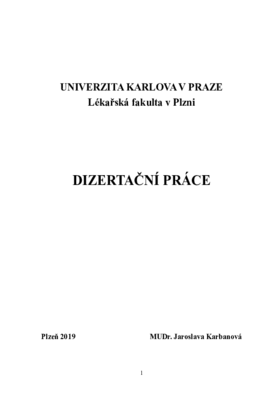Technické aspekty druhé doby porodní
Technical Aspects of the Second Stage of Labor
dizertační práce (OBHÁJENO)

Zobrazit/
Trvalý odkaz
http://hdl.handle.net/20.500.11956/110377Identifikátory
SIS: 106837
Kolekce
- Kvalifikační práce [319]
Autor
Vedoucí práce
Oponent práce
Procházka, Martin
Záhumenský, Jozef
Fakulta / součást
Lékařská fakulta v Plzni
Obor
-
Katedra / ústav / klinika
Klinika gynekologicko - porodnická
Datum obhajoby
19. 9. 2019
Nakladatel
Univerzita Karlova, Lékařská fakulta v PlzniJazyk
Čeština
Známka
Prospěl/a
Klíčová slova (česky)
anální inkontinence, dyspareunie, episiotomie, chránění hráze, komplikace hojení, perineální bolest, poranění análního svěrače, porodní poranění, sexualitaKlíčová slova (anglicky)
anal incontinence, anal sphincter trauma, dyspareunia, episiotomy, healing complications, manual perineal protection, obstetrical trauma, perineal pain, sexualityPorodnické intervence mají za cíl případný abnormální nebo patologický porod co nejvíce normalizovat. V některých případech (např. fetální distress) toto není zcela možné. Poté je jejich cílem porod urychlit bez inadekvátního vzestupu rizika maternálního nebo neonatálního traumatu. Cílem této dizertační práce bylo některé tyto intervence moderně definovat a navrhnout jejich správné provedení. Z tohoto důvodu bylo rovněž nutné správně popsat situaci, ve které se porodník a/nebo rodička nacházejí v době provádění některé z těchto intervencí. Bylo proto nutné nahlédnout na chování perinea ve druhé době porodní a kvantifikovat a určit hlavní vektory jeho deformace. Na podkladě rozsahu této deformace bylo možné adekvátně popsat a provést některé porodnické intervence (v případě této dizertační práce různý typ episiotomie) nebo zhodnotit různé modifikace počítačově (v případě manuální perineální protekce), které mohou mít tak malé nebo tak obtížně měřitelné rozdíly, že by jejich zhodnocení v klinické praxi bylo z důvodu interindividuální nepřesnosti či velmi krátkého trvání intervence nemožné. Popsali jsme největší napětí na povrchu hráze v průběhu vaginálního porodu, které je v příčném, transverzálním směru s maximem v oblasti zadní komisury. Rovněž jsme toto napětí kvantifikovali, deformace perinea v...
Obstetrical intervantion`s goal is to normalize an abnormal or pathological course of labour. In a certain case (e.g. fetal distress) this is not fully achievable. Then the goal is to accelerate the delivery without inadequate increase of risk of maternal or neonatal trauma. The aim of this dizertation thesis was to offer an up-to-date definition and to outline a proper performance of these interventions. Therefore, it was necessary to properly and timely describe the labour layout in which the accoucheur and/or the parturient happen to occurr when an intervention is to take place. It was essential to describe the quantity of perineal loading as well as to define the main vector of perineal strain and deformation. Based on the range of this deformation it was subsequently possible to adequately describe and execute some obstetrical interventions (e.g. a variety of types of episiotomy) or to evaluate a variety of modifications by means of computational modelling (e.g. manual perineal protection) that might have so tiny nuances between each other or differences that are difficult to measure because the clinical evaluation is impossible due to interindividual imprecision or very short duration of the intervention. We described the maximum strain on the perineal surface during vaginal delivery that...
